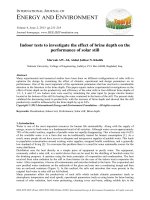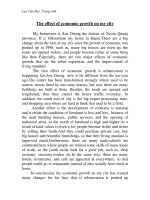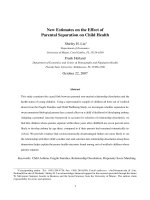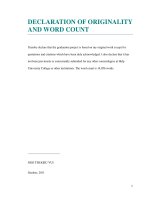The effect of knowledge management on organizational innovation: Evidence from banking industry
Bạn đang xem bản rút gọn của tài liệu. Xem và tải ngay bản đầy đủ của tài liệu tại đây (907.08 KB, 8 trang )
Accounting 3 (2017) 237–244
Contents lists available at GrowingScience
Accounting
homepage: www.GrowingScience.com/ac/ac.html
The effect of knowledge management on organizational innovation: Evidence from banking
industry
Ali Valipoura, Mohammad Pasandidehfarb ,and Vida Rahim Hashemabadic*
a
Department of Management & Accounting (Marketing Ph.D group), Abhar Branch Islamic Azad University, Abhar, Iran
Department of Management & Accounting (Accounting group), Science & Research Branch Islamic Azad University, Shahre-Qods, Iran
c
Faran Mehr Danesh Virtual Institute for Higher Education, Tehran, Iran
b
CHRONICLE
Article history:
Received September 5, 2016
Received in revised format
November 11 2016
Accepted January 10 2016
Available online
January 11 2017
Keywords:
Knowledge management
Empowerment
Innovation
Agricultural Bank of Iran
ABSTRACT
Knowledge management is frequently identified as an important antecedent of innovation.
However, few empirical studies have specifically addressed antecedents and consequences of
effective knowledge management. Today, domestic organizations are compelled, as well as
other international organizations and have to compete to stay in business environment. Hence,
they must be innovative. The purpose of this study is to evaluate the effect of knowledge
management on employee's innovation in organizations through empowerment as a mediator
for a case study of the Agricultural Bank of Qazvin province of Iran. Required information was
gathered by a self-made questionnaire adapted and based on conceptual model adapted from
previous studies. The population of this study consists of 369 employees of the Agricultural
Bank of Qazvin. A total of 200 questionnaires were distributed, in which 188 valid
questionnaires were collected. These questionnaires were distributed randomly among the male
and female employees in branches of Agricultural Bank. The questionnaire is conducted by
factor analysis and the reliability is measured by Cronbach's alpha. The structural equation
modeling is used for data analysis. The results reveal the fact that empowerment will lead to
employee's innovation. However, other variables did not have any significant and direct or
indirect effect on employee's innovation.
© 2017 Growing Science Ltd. All rights reserved.
1. Introduction
The rapid development of high technology, information and communications technologies have urged
many organizations to seek actively for new ways, ideas, experimentations, and creative solutions in
improving their current products, processes, systems and technologies, commonly referred as
organizational innovation. (Tan & Nasurdin, 2011). The learning process occurs to improve the stock
of knowledge available to the organization and to amplify the value of its intellectual assets, such as
innovation capital when knowledge is acquired and applied. If an organization demonstrates
competence in knowledge management, it can be considered as having a knowledge managementorientation (Darroch & McNaughton, 2002).
* Corresponding author.
E-mail address: (V. Rahim Hashemabadi)
© 2017 Growing Science Ltd. All rights reserved.
doi: 10.5267/j.ac.2017.1.002
238
Knowledge management has been broadly defined from different perspectives. Wiig (1997) viewed as
a set of activities that lead an organization in acquiring knowledge both internally and externally.
According to Salisbury (2003), knowledge management is defined as the deployment of a
comprehensive system that enhances the growth of an organization’s knowledge. In an effort to expand
the knowledge management discipline, knowledge management can be defined as the management
functions that encompass the creation of knowledge, management of the flow of knowledge within the
organization, and usage of knowledge in an effective and efficient manner for the long-term benefit of
the organization (Darroch & McNaughton, 2002). Hence, knowledge management effectiveness is
regarded as a management discipline, which focuses on the development and usage of knowledge to
support the achievement of strategic business objectives.
2. Literature review
The recognition of market opportunities is very important towards appropriate positioning in order to
achieve competitive advantage. Investigating these opportunities through innovative ways needs
special knowledge, creative ideas, and the capability to recognize user/customer decision making and
practical thoughts (Nonaka & Toyama, 2007). Based on those requirements, the ability to recognize
opportunities partly relies on the people’s learning capabilities and extant knowledge (Teece, 2007).
Today’s organizations are interested in stimulating knowledge, which is the biggest possible asset of
organizations (Akgun et al., 2007). The growing interest in organizational knowledge has highlighted
the managing the knowledge to the organization’s advantage as well (Alavi & Leidner, 1999).
Therefore, the concept of Knowledge Management (KM) draws a substantial interest and various
definitions of KM have appeared in the extant literature. According to Davenport (1996), KM is either
a philosophical or a technological level, with little pragmatic discussion on how knowledge can be
managed and implemented. The best utilization of the organizational knowledge, though, has been
determined by Parlby and Taylor (2000), as a vehicle, which backs innovation, creates new ideas and
exploits the organization’s thinking power. Moreover, the process of managing organizational
knowledge has been considered in terms of value creation through organizational intangible assets.
According to Malhotra (1997), KM is a regulative principle aimed to meet customer expectations. She
also recommends that by providing the right knowledge to the right people at the right time, KM
methods make it possible for organizations to design dynamic processes and to exploit their human
resources, efficiently. The latter rationale discloses a hidden concept of collective knowledge referred
by von Krogh (1998) in his argument that KM detects the collective knowledge in a firm to help this
organization compete. Some people exploit the notion of collective knowledge together with the
corporate knowledge to explain KM as the process in which organizations create and make use of their
own aforementioned kinds of knowledge (Gunsela et al., 2011). In another view proposed by Kebede
(2010), KM is the creation and management of an environment, which encourages knowledge to be
constructed, shared, learnt, enhanced, and organized to help the organization.
Since the main factor that will bring the organizations a competitive advantage is “human”, the idea
that using the employees’ knowledge, skills and capabilities in an efficient and effective manner will
significantly contribute to achievement of the strategic targets of the enterprises has introduced the
strategic human resources approach. In this context, Strategic Human Resources Practices, by way of
its applications, establishes connection between the business needs and organizational activities, unite
and guide the employees in line with the business strategies and provide the firms with a competitive
advantage (Liao et al., 2009). Therefore, it is stated that the Strategic Human Resources Practices
applications will give the enterprise with a competitive advantage, which cannot be imitated or
substituted. Therefore, we may ensure that the employees act in accordance with the firm’s strategies
and targets, that the expected behaviors are guaranteed by means of the planned trainings, that the
employees are motivated become more participant by efficient practices (Fındıklı, et al. 2015).
Innovation generally implies the adoption of an idea or behavior, which is new for the organization.
Innovation can be in the form of a new product or service, a new production process technology, a new
A. Valipour et al. / Accounting 3 (2017)
239
structure or administrative system, or a new plan for organizational members (Tan. & Nasurdin, 2010).
Organizational innovation is a multidimensional concept that pertains to different operations of any
firm. The nature of the activities in each innovation type is different, and they necessitate various
strategies. There are three pairs of organizational innovation, which are administrative and technical,
product and process, and radical and incremental, that has absorbed substantial amount of attention in
previous studies (Kör & Maden, 2013).
Knowledge sharing is described as a business process that needs collective knowledge, skills and
expertise, and distribution of knowledge across the organizational units (Chen & Huang, 2009).
Knowledge sharing also includes the exchange of employee knowledge, experiences, and skills
throughout the organizational and the whole firm to build new mental models (Lin, 2007).
Organizational members can easily reach the knowledge by sharing knowledge among themselves
and/or across various units, which reduces the amount of time and investment needed to collect
information. By reducing time and investment for collecting information and building new mental
models, firms can transfer their valuable resources to innovation processes. Additionally, sharing and
exchanging knowledge cause high level of participation in learning new knowledge, which are essential
for the development innovative ideas (Chen & Huang, 2009) . Thus, knowledge-sharing processes
appears to be positively associated with innovation. Based on the definitions, we may conclude that the
KM represents a process whose processes are different from one study to another one. For instance,
Davenport (1996) defines it as knowledge generation, information coding, coordination and
information transfer; and Malhotra (2003) as information awareness, determination of the purposes of
knowledge, implementation, dissemination, improvement and storage. Bharadwaj et al. (2005) revealed
that the KM capacity of firms consists of obtaining, sharing, implementing and assessing processes.
Gold et al. (2001) also addressed the KM processes in four stages; namely, information collection,
conversion of information into available information (information internalization), implementation
(information sharing - information assessment), and information safe-keeping. It can be said that the
aspects determined by the researchers are associated with the processes in terms of information
acquisition, information sharing and implementing (Chen & Huang, 2009).
3.
Problem definition
Today's world is full of complexity that puts organizations into serious challenges in terms of growth
and excellence and managers as planners, organizers and leaders of humanity are faced with many
challenges. They should be able to be superior to its competitors, at least in one field and have an
advantage over them to convince their customers. In other words, they have no choice but to be
innovative. To make innovation happening in organization, at first it is essential that managers have
the necessary knowledge about the internal and external factors that influence on the
organization. Second, knowledge has to flow freely throughout the organization. Finally, an
organization must be responsible. In fact, innovation is a response. Therefore, the organization, which
is responsive and agile is more likely to be more innovative. The present study is a survey on the effects
of KM initiatives on innovation in the organization. So the main question of this research is to find out
about the effect of KM dimensions on employee's innovation in the Agricultural Bank in Qazvin?
4. Hypotheses
Knowledge Creation has significant effect on the employee's empowerment in the Agricultural
Bank of Iran.
Knowledge Storage has significant effect on the employee's empowerment in the Agricultural
Bank of Iran.
Knowledge sharing (knowledge Distribution) has significant effect on the employee's
Empowerment in the Agricultural Bank of Iran.
Knowledge Application has significant effect on the employee's empowerment in the
Agricultural Bank of Iran.
240
Knowledge Creation has significant effect on the employee's Innovation in the Agricultural
Bank of Iran.
Knowledge Storage has significant effect on the employee's Innovation in the Agricultural Bank
of Iran.
Knowledge sharing (knowledge Distribution) has significant effect on the employee's
Innovation in the Agricultural Bank of Iran.
Knowledge Application has significant effect on the employee's Innovation in the Agricultural
Bank of Iran.
Employee's Empowerment has significant effect on the employee's Innovation in the
Agricultural Bank of Iran.
Fig. 1. Conceptual Model, adapted from (Liu & Tsai, 2009)
Fig. 1 shows the structure of the proposed study.
5. Research design and methods of data analysis
This research is based on applied method and the nature of research is descriptive-survey. The
population of the research are employees of Agricultural Bank of Qazvin province in Iran, which in
this study, 188 patients were evaluated as the sample size. In this study, information was collected on
field study and library. To gather information, self-made questionnaires have been used with regard to
the dimensions and variables and the subject of the necessary validity and reliability. Cronbach's alpha
coefficient was calculated at the rate of 0.917. SPSS-22 and LISREL-8.8 software were used to analyze
the collected data. In order to categorize and summarize the findings of descriptive statistics (frequency
tables and charts for demographics), and to achieve the goals were used of inferential statistics.
5.1. Theoretical framework of research
The theoretical framework is fundamental that all research is based on. This framework is Logical,
descriptive and cultured network including the relationships among the variables seeking to implement
procedures including interviews, observation and review of the literature. After identifying the
appropriate variables we must develop a network of relationships among the variables to be created and
then tested assumptions associated with them. The theoretical framework clarifies the relationship
between variables as the theoretical framework forms the basis of the literature review. This means that
literature review may identify variables that are important and in fact are the findings of previous
studies. The theoretical framework provides a good basis for formulating testable, reasonably and
necessary hypotheses (Sekaran, 2003). In this study, we discussed and examined the impact of
knowledge management on employee's innovation by mediating role of employee's empowerment in
the Agricultural Bank in Qazvin. Thus, according to the literature and conceptual model, the knowledge
management dimensions are independent variables and employee's empowerment is mediating variable
and employee's innovation is dependent variable.
5.2. Population and sample size
The population consisted of 369 Agricultural Bank staff in Qazvin. For sampling, a simple random
sampling method is used. Since the population in this study is limited and available, for determining
241
A. Valipour et al. / Accounting 3 (2017)
the sample size, Cochran's sample size formula was used and according to this formula, the sample size
of 188 is calculated as follows:
369
0/05
1
0/5
1/96
1022
1/96
0/5
0/5
0/5
≅ 188
5.3. Data collection tools
To gather the information related to literature and research literature, library method is used and to
collect data to confirm or refute the hypothesis of the study, a questionnaire is used.
1General inquiries: in the general questions, we try to collect sufficient information and
demographics on the respondents. This section consists of five questions (age, years of service,
gender, marital status and educational level of the respondents).
2Specific questions: This section consists of 22 questions to assess the components of knowledge
management and 10 questions to assess the employee's empowerment and 6 questions to assess the
employee's innovation.
38 questions of 38 questions were eliminated due to their low factor loading coefficients.
The questionnaire is based on five-item Likert scale.
6.
Validity and Reliability
Validity of the questionnaire of this study was based on content validity. The questionnaire was used
according to the research hypotheses and then confirmed by experts. To estimate the reliability of the
questionnaire Cronbach's alpha was used and it was equal to 0.869. In our survey, 62% of the
participants were male and 38% of them were female. In terms of marital status, 83% of them were
married and 17% of them were single. Other descriptive information are summarized as follows,
5%
6%
3% 6%
9%
24%
24%
34%
32%
21%
53%
57%
26%
5>
5--10
10--15
15--20
Job experience
20<
20--30
31--40
Age
41--50
50<
12>
14
16
18
Years of education
7. Inferential statistics
To determine the normality of data distribution of collected data, the Kolmogorov – Smirnov test was
implemented and the results are summarized in Table. As we can observe from the results of Table 1,
all variables are normally distributed when the level of significance is five percent. Next, we present
details of the measurement of factors loadings and testing the hypotheses of the survey. The criterion
for suitability factor loadings coefficients is equal to 0.5. 8 questions of 38 questions have a load factor
less than 0.5. These questions must be removed for continuing analysis. After removal of these
questions, all of the questions in the questionnaire have load factors greater than 0.5 that indicates the
suitability of this measure. Fig. 1 and Fig. 2 shows details of our survey.
242
Table 1
The results of the Kolmogorov – Smirnov test
N
Normal Parametersa,b Mean
Std. Deviation
Most Extreme
Absolute
Differences
Positive
Negative
Test Statistic
Asymp. Sig. (2-tailed)
Creation
188
2.9639
.66649
.058
.043
-.058
.058
.200c,d
Sharing _
distribution
188
3.4053
.76959
.095
.059
-.095
.095
.000c
Storage
188
3.3096
.68515
.116
.088
-.116
.116
.000c
Fig. 1. Measearment model afer modification with standard
coefficients
Application
188
3.2830
.73385
.111
.067
-.111
.111
.000c
Empowerment
188
3.1936
.62090
.058
.049
-.058
.058
.200c,d
Innovation
188
3.2012
.67606
.064
.042
-.064
.064
.056c
Fig. 2. Measurement model after modification (T. values)
7.1. Structural Model tests
Structural model studies the relationships between different variables. In fact, the relationships between
these variables indicate approval or disapproval hypotheses. Before entering this section, we must make
sure of the model fitness.
Table 2
Control of the most important indicators in the evaluation of model fitness
indicator
RMSEA
PFNI
AGFI
RFI
CFI
NFI
IFI
NNFI
/
Value
1.87
Limit for acceptance
Less than 3
Approval / rejection
Approved
0.068
0.79
0.75
0.87
0.94
0.88
0.94
0.93
Less than 0.1
Greater than 0.5
Greater than 0.8
Greater than 0.9
Greater than 0.9
Greater than 0.9
Greater than 0.9
Greater than 0.9
Approved
Approved
rejected
rejected
Approved
rejected
Approved
Approved
RMSEA: The Root Mean Square Error of Approximation
AGFI: The adjusted goodness of fit index
RFI: Relative Fit Index
NFI: Normed Fit Index
IFI: Incremental Fit Index
CFI: Comparative Fit Index
NNFI: Non-normed fit index
Table 2 demonstrates the summary of the statistical observations. As we can observe from the results,
all statistics are within desirable levels. Fig. 3 and Fig. 4 show details of testing the hypotheses of the
survey. Based on the estimated path coefficients in the structural model, the direct and indirect effects
of all variables on the dependent variable are obtained and summarized in Table 3 as follows,
243
A. Valipour et al. / Accounting 3 (2017)
Table 3
An overview of coefficients
Hypotheses
1
2
3
4
5
6
7
8
9
Independent Variable
Knowledge Creation
Knowledge Creation
Knowledge Storage
Knowledge Storage
Knowledge Sharing
Knowledge Sharing
Knowledge Application
Knowledge Application
Employee's Empowerment
Dependent Variable
Employee's Empowerment
Employee's Innovation
Employee's Empowerment
Employee's Innovation
Employee's Empowerment
Employee's Innovation
Employee's Empowerment
Employee's Innovation
Employee's Innovation
Fig. 3. Structural model with standard coefficients
Impact Coefficient
0.13
-0.08
t-value
1.27
-0.63
0.07
0.63
0.28
-0.30
0.48
3.41
1.41
-1.22
0.44
-0.22
2.51
-1.00
0.86
3.81
Result
rejected
rejected
rejected
Direct & significant Impact
rejected
rejected
Direct & significant Impact
rejected
Direct & significant Impact
Fig. 4. Structural model with t-values coefficients
8. Conclusion and suggestions
In this study, we have investigated the effect of KM initiatives on innovation, both directly and through
employee empowerment mediator. In order to test the model, fitness indexes were studied. After a
correction phase and eliminating some of the inappropriate questions in the questionnaire, goodness of
fit of model was approved. After the analysis by LISREL software and software-based modifications,
the results have shown that knowledge storage had direct effect on employees' innovation and
knowledge application had direct effect on employee empowerment in Agricultural Bank. The results
have also revealed the fact that empowerment of employees would lead to innovation by them. Other
variables did not have any impact on innovation directly or through employee empowerment.
References
Akgun, A., Keskin, H., & Gunsel, A. (2007). Communities Of Practice: An Important Actor Of
Organizational Learning, From the Proceedings of III. International Strategic Management
Conference. Antalya Turkey.
Alavi, M., & Leidner, D. (1999). Knowledge management systems: Issues, challenges, and benefits.
Communications of the AIS, 1(5), 1-35.
Bharadwaj, S., Bhushan, S., & Saxena, C. (2005). Knowledge Management in Global Software Teams.
Vikalpa, 30(4), 65-75.
Chen, C.-J., & Huang, J.-W. (2009). Strategic Human Resource Practices and Innovation Performance
- The Mediating Role of Knowledge Management Capacity. Journal of Business Research, 62, 104114.
Darroch, J., & McNaughton, R. (2002). Examining the link between knowledge management practice
and types of innovation. Journal of Intellectual Capital, 3(3), 210-222.
Davenport, T. (1996). Some principles of knowledge management. Strategy & Business, 1(2), 34-40.
Fındıklı, M., Yozgat, U., & Rofcanin, Y. (2015). Examining Organizational Innovation and Knowledge
Management Capacity The Central Role of Strategic Human Resources Practices. Procedia - Social
and Behavioral Sciences, 181, 377-387.
244
Gold, H., Malhotra, A., & Segars, A. (2001). Knowledge Management: An Organizational Capabilities
Perspective. Journal of Management Information Systems, 18, 185-214.
Gunsela, A., Siachou, E., & Acar, A. (2011). Knowledge Management And Learning Capability To
Enhance Organizational Innovativeness. Procedia Social and Behavioral Sciences, 24, 880-888.
Kebede, G. (2010). Knowledge management: An information science perspective. International
Journal of Information Management, 30, 416-424.
Kör, B., & Maden, C. (2013). The Relationship between Knowledge Management and Innovation in
Turkish Service and High-Tech Firms. International Journal of Business and Social Science, 4(4),
293-304.
Liao, S.-H., Wu, C.-C., Hu, D.-C., & Tsuei, G. (2009). Knowledge Acquisition, Absorptive
Capacity,and Innovation Capability: An Empirical Study of Taiwan's Knowledge-Intensive
Industries. International Journal of Social, Behavioral, Educational, Economic, Business and
Industrial Engineering, 3(5), 338-345.
Lin, H. (2007). Knowledge sharing and firm innovation capability: an empirical study. International
Journal of Manpower, 28(3/4), 315-332.
Liu, P.-L., & Tsai, C.-H. (2009). A Study on the Relationship between Knowledge Management,
Knowledge Absorption and Innovative Management Capabilities in Taiwan’s High-tech Industries.
International Journal of The Computer, the Internet and Management , 1-17.
Malhotra, Y. (1997). Knowledge management in inquiring organizations. 3rd Americas Conference on
Information Systems, (pp. 239-295). Indianapolis.
Malhotra., Y. (2003). Is Knowledge the Ultimate Competitive Advantage? Business Management Asia,
3(4), 66-69.
Nonaka, I., & Toyama, R. (2007). Strategic management as distributed practical wisdom
(phronesis). Industrial and Corporate Change, 16(3), 371-394.
Parlby, D., & Taylor, R. (2000). The power of knowledge: a business guide to knowledge management.
Retrieved from />Pelit, E., & Pelit, N. (2014). The Effects of Mobbing on Organizational Cynicism: A Study on Hotels
in Turkey. International Journal of Human Resource Studies, 2162-3058.
Salisbury, M. (2003). Putting theory into practice to build knowledge management systems. Journal of
Knowledge Management, 7(2), 128-141.
Sekaran, U. (2003). Research methods for business : a skill-building approach. New York: Wiley.
Tan, C., & Nasurdin, A. (2011). Human Resource Management Practices and Organizational
Innovation: Assessing the Mediating Role of Knowledge Management Effectiveness. Electronic
Journal of Knowledge Management, 9(2), 155-167.
Tan., C. L., & Nasurdin, A. M. (2010). Knowledge Management Effectiveness and Technological
Innovation: An Empirical Study in the Malaysian Manufacturing Industry. Journal of Mobile
Technologies, Knowledge and Society. doi:10.5171/2010.428053
Teece, D. (2007). Explicating dynamic capabilities: The nature and microfoundations of (sustainable)
enterprise performance. Strategic Management Journal, 28(13), 1319–1350.
Tsai, Y. (2011). Relationship between Organizational Culture,Leadership Behavior and Job
Satisfaction. Health Services Research, 1472-6963.
Von Krogh, G. (1998). Care in knowledge creation. California Management Review, 40(30), 133-154.
Watson, T. (2006). Organising and Managing Work. london: UK: Pearson.
Wiig, K. (1997). Knowledge management: Where did it come from and where will it go? Expert
Systems with Applications, 13(1), 1-14.
© 2017 by the authors; licensee Growing Science, Canada. This is an open access
article distributed under the terms and conditions of the Creative Commons Attribution
(CC-BY) license ( />









